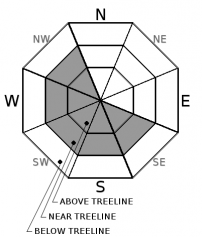| Wednesday | Wednesday Night | Thursday | |
|---|---|---|---|
| Weather: | Sunny | Clear | Sunny |
| Temperatures: | 36 to 41 deg. F. | 19 to 25 deg. F. | 41 to 46 deg. F. |
| Mid Slope Winds: | East | East | East |
| Wind Speed: | Light in the morning increasing to 10 to 15 mph with gusts to 30 mph in the afternoon | 10 to 15 mph with gusts to 40 mph | 10 to 15 mph with gusts to 35 mph in the morning becoming light in the afternoon |
| Expected snowfall: | 0 | 0 | 0 |
| Wednesday | Wednesday Night | Thursday | |
|---|---|---|---|
| Weather: | Sunny | Clear | Sunny |
| Temperatures: | 35 to 40 deg. F. | 19 to 24 deg. F. | 39 to 44 deg. F. |
| Ridge Top Winds: | East | East | East becoming southeast in the afternoon |
| Wind Speed: | 15 to 25 mph with gusts to 30 mph increasing to 45 mph in the afternoon | 20 to 35 mph with gusts to 60 mph | 20 to 30 mph with gusts to 50 mph decreasing to 10 to 15 mph with gusts to 40 mph in the afternoon |
| Expected snowfall: | 0 | 0 | 0 |

























